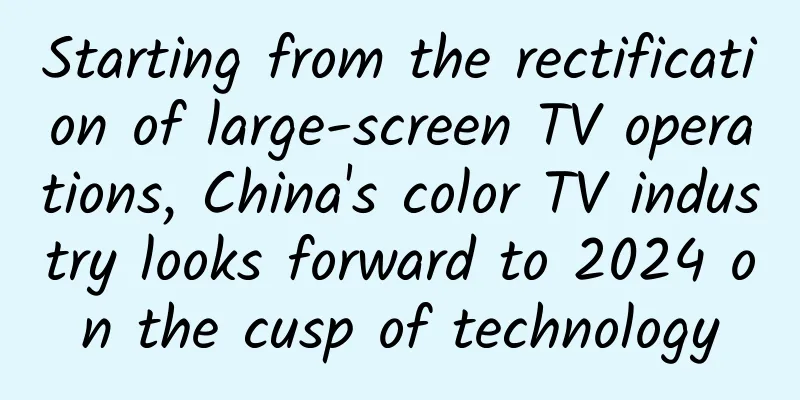Starting from the rectification of large-screen TV operations, China's color TV industry looks forward to 2024 on the cusp of technology

|
More than a decade ago, smart TVs were once very popular, led by massive content and large-screen experience. However, the reality that followed was a mess: cumbersome operation, constant pop-up ads, and headache-inducing "nesting doll" charges... Consumers have mixed feelings about it, and the conflicts caused by it have also aroused widespread public discussion. At the beginning of 2023, an ordinary netizen's complaint that "watching TV is too strenuous" unexpectedly became a hot search, and the various embarrassments accumulated by smart TVs during their rapid development in the past began to be revealed - TV has become a "large monitor" placed in the center of the living room but ignored. Especially for millennials, TV has long become an outdated entertainment tool. What is even more disturbing to the industry is that this phenomenon is not only reflected in the change of user concepts, but also directly reflected in market sales data. The past decade has seen a sharp decline in China's color TV market. In 2016, the sales volume of the entire color TV industry was still 50.89 million units, but by 2022, just six years later, the sales volume had dropped sharply to 36.34 million units. Aowei Cloud Network's report for the first half of 2023 pointed out that the current sales volume is only 14.67 million units, compared with 16.72 million units in the same period last year. Televisions are not selling well and consumers are not watching TV anymore. The latest report from the authoritative media People's Daily Online pointed out that the Chinese television market has undergone drastic changes. Last year, the power-on rate was less than 30%, which was nearly half of that ten years ago. What happened to the TV market? Although there are many reasons for the decline, its difficulty in use is undoubtedly the key factor that accelerates the market contraction. In the era of smart TV, why has watching TV become more troublesome? Annoying startup ads, headache-inducing charging models, and ubiquitous ads are problems that have existed in the smart TV field for a full decade. It seems that the problem is concentrated on the user experience of smart TVs. In fact, the root of the problem lies in the fact that the entire industry chain has built a profit distribution system and profit model with these problems at the core. This is not just a binary problem of either this or that, but a complex "interest chain" problem. For example, cable TV fees are service fees for cable TV networks and have nothing to do with content payments. The same is true for IPTV service fees. The "Internet TV function" that seems to require no initial network service fees actually requires the opening and maintenance fees of the cable network. This means that from the consumer's perspective, different fees may need to be purchased, and different TVs may even require different boxes and remote controls. The core of these problems is that consumers need to deal with the "content product monetization" problem of numerous content providers, content platforms and independent content. This is a typical "supply-side" problem, and solving it requires the establishment of a unified national market rules and environment. In addition, there are also issues such as the isolation of different ecosystems and the value logic of content of different natures. The current situation is so chaotic that it makes solving problems in the television field extremely difficult. Obviously, changing this situation requires the joint efforts of the entire industry chain and the establishment of unified market rules. This requires launching a supply-side reform from the perspective of top-level management that truly aims at "serving the audience." In August this year, the State Administration of Radio, Film and Television launched a heavy-handed attack on the problems of complicated television charges and difficult operation. It held a crucial meeting in Beijing and proposed a series of reform measures aimed at the core of the problem: making the use of television simpler and more intuitive. For example, the new measures require that the startup time of Internet TV be limited to 5 seconds, and strict regulations are set for the response time of key functions such as play, pause, fast forward, etc. Although there is still room for improvement in the maximum startup time of 35 seconds for IPTV services, the State Administration of Radio, Film and Television has shown its determination to solve the problem by reducing the fee packages for IPTV. These reforms are a key step in the right direction, and while it will take time and continued effort to fully meet consumers' expectations and address the industry's deep-seated problems, they have brought new vitality to the smart TV industry. This change not only improves user experience, but also lays the foundation for the healthy development of the TV industry in the future. Smart TVs are not obsolete, but need to keep pace with the times and redefine life experience In fact, when it comes to smart TV, we complain about it not because it is outdated, but more because we expect it to provide us with more convenient services. With the rapid development of technology today, TV is no longer just a screen, it is the center of home entertainment and the window of home interconnection. In this digital age, the stunning picture quality and sound provided by TV are still irreplaceable, allowing us to immerse ourselves in movies, sports events and games. However, just like from Nokia to iPhone, today's TV should not simply provide the function of "watching", but should give a comprehensive leap in experience. According to a report by the Prospective Industry Research Institute, more than 86% of users expect smart TVs to provide richer content and convenient operation methods, similar to smartphones. In short, "playing TV" and "watching TV" are the new trends in TV consumption. Television will not be eliminated, but it does need to keep pace with the times and evolve to meet the audience's needs for entertainment, information and interaction. This requires rapid iteration of television technology itself. In 2023, the relevant technologies of smart devices are evolving in full swing, and AI big model technology has become the focus of the science and technology community. It has not only subverted the concept of traditional artificial intelligence, but also spawned a technological revolution across multiple industries. It is foreseeable that with the rapid development of AI technology, smart TVs will become more multifunctional. Under the strategy of "Future TV", it will surely promote the industry's progress in voice and interactive technology, promote the research and development and application of AI products through personalized services, and let consumers truly experience the convenience brought by technological innovation and change. Unlocking more life scenarios, product innovation promotes market growth The beauty of television is that it can cater to a variety of needs across age groups and family members. For young people, 4K video streaming, music and games are their keywords, and they also need it to have features such as high refresh rate, low input delay and game mode to satisfy their love of games. In addition, sound quality is also very important to young people, and they expect better sound systems or connection options with audio equipment. Take TCL for example. They have been doing some cool things in the field of color TV. A few years ago, they began to try to cooperate with world-renowned Internet companies, such as Google and Amazon, to launch a series of novel products and services in the European, American and Southeast Asian markets. They also set up a place called "Honghu Laboratory" to add more intelligent functions and leading technologies to TVs to make them more in line with the viewing habits of modern users. As for the elderly, they pay more attention to the simplicity and ease of use of smart TVs, hoping that the interface is simple and easy to operate, and avoid complicated settings. They need large fonts and high-contrast text so that they can easily read the information on the TV. This year, TCL launched a new hit product, C11G Pro. One of the core highlights is its smart desktop system, which aims to solve the long-standing user experience problems of smart TVs. Imagine no more annoying ads when turning on the TV, a simple remote control, and a friendly interface. In just a moment, you can step into a clear visual world. This simple and efficient experience is indeed a very comfortable viewing experience for the elderly. The functionality of a TV also differs when it comes to the needs of children. Parents are concerned about the security of smart TVs to ensure that their children do not access content that is not suitable for them. Imagine a colorful smart TV screen that becomes a magical window for children to explore the world of knowledge. For those curious preschool and elementary school children, this TV is not only an entertainment corner, but also a fun learning paradise. They can enter a customized early education world by touching the screen, learn the mysteries of natural science from the relaxed and enjoyable animation courses, or easily master the basics of foreign languages in interactive games. In this virtual park, there are also a series of physical training courses designed specifically for children, such as children's yoga and dance. Children can follow the guidance on the screen to make elegant yoga poses or dance to cheerful music in the comfort of their own home to enhance their physical fitness. In addition, during leisure time, the whole family sits in front of the smart TV and participates in parent-child entertainment activities, such as solving puzzles in educational games or watching a delicious dinner together. These activities not only enhance children's hands-on ability and problem-solving ability, but more importantly, they bring family members closer together. Smart TV, which was once just a simple viewing tool in the corner of the home, will transform into an all-round star in family life. It not only plays your favorite TV series and movies, but also becomes a versatile tool for family entertainment, health care and education. The color TV industry is currently at a turning point. It faces not only the critical eyes of consumers, but also the challenges brought by the rapid iteration of technology. However, there are always opportunities behind the challenges. The recent policy reforms are the catalysts that push the industry towards a more user-friendly direction. The revolutionary progress of AI big models has given rise to a more far-reaching change, which will not only push the TV industry towards a simpler and smarter direction, but also open a new era of TV viewing. In this era, every interaction between people and TV screens will become more smooth, intuitive and personalized, completely changing the way we connect with TV. In the future, smart TVs will no longer be just background panels in the living room, but will become the core of family life. From traditional viewing functions to the control center of smart homes, smart TVs are moving towards a new era of multi-functions and high interactivity. All in all, despite the current challenges, the future of smart TV is still bright. It will not only survive, but also develop in a smarter and more modern way, more intelligent, more connected and more personalized. The pictures in this article are from the Internet As a winner of Toutiao's Qingyun Plan and Baijiahao's Bai+ Plan, the 2019 Baidu Digital Author of the Year, the Baijiahao's Most Popular Author in the Technology Field, the 2019 Sogou Technology and Culture Author, and the 2021 Baijiahao Quarterly Influential Creator, he has won many awards, including the 2013 Sohu Best Industry Media Person, the 2015 China New Media Entrepreneurship Competition Beijing Third Place, the 2015 Guangmang Experience Award, the 2015 China New Media Entrepreneurship Competition Finals Third Place, and the 2018 Baidu Dynamic Annual Powerful Celebrity. |
<<: Cheating your money + ruining your eyes! Whoever buys a wide color gamut TV will regret it
Recommend
Is it expensive to produce the Gannan Building Materials mini program? Gannan Building Materials Mini Program Production Cost List
There is no fixed price for the production of the...
Embarcadero: Best mobile cross-platform development tool RAD Studio
Embarcadero, an American independent software com...
Brush your teeth after meals, trim your nails frequently... these seemingly "hygienic" good habits, but you may have been doing them wrong!
We have been instilled with the awareness of &quo...
iFlytek’s real dilemma: customers become rivals, technological advantages gradually disappear, and profitability track is uncertain
As former customers such as BAT have become rival...
Owl: I am a “round owl”, not a “Yuanxiao”!
As we all know, the symbol of the Lantern Festiva...
Trapped ASUS: Is its decline an accident or a destiny?
Another company that was once a global leader has...
Comic: The Amazing Power of Quantum
Reviewer: Luo Huiqian, Associate Researcher, Inst...
Volvo has become a "Tesla" after announcing its abandonment of traditional energy vehicles
Tesla may really be facing a rival. Just days aft...
Can’t write good copy? That’s because user needs are not grasped! !
What do we think about when we think about writin...
One training session consumes 24 million kWh of electricity. Why does AI consume so much electricity?
Just the GPU of GPT-4 consumes 24 million kWh of ...
iOS 16 will free your iPhone from those annoying verification codes and spam ads
iOS 16 is Apple's upcoming iPhone software up...
What is Mini Program traffic exchange? How does traffic exchange work in WeChat Mini Program?
Q: What is the Mini Program exchange? A: Mini Pro...
The most complete! Practical guide to operating Douyin corporate accounts!
Douyin is undoubtedly an important battlefield fo...
Is it okay to eat more shrimps if you are allergic to them? Don't be silly, many people have been admitted to the ICU because of this
"If you are allergic to a certain food, just...
Tesla's Q2 revenue was $2.8 billion, with a net loss of $300 million and its automotive revenue doubled year-on-year
On August 3, Tesla announced its second quarter f...









